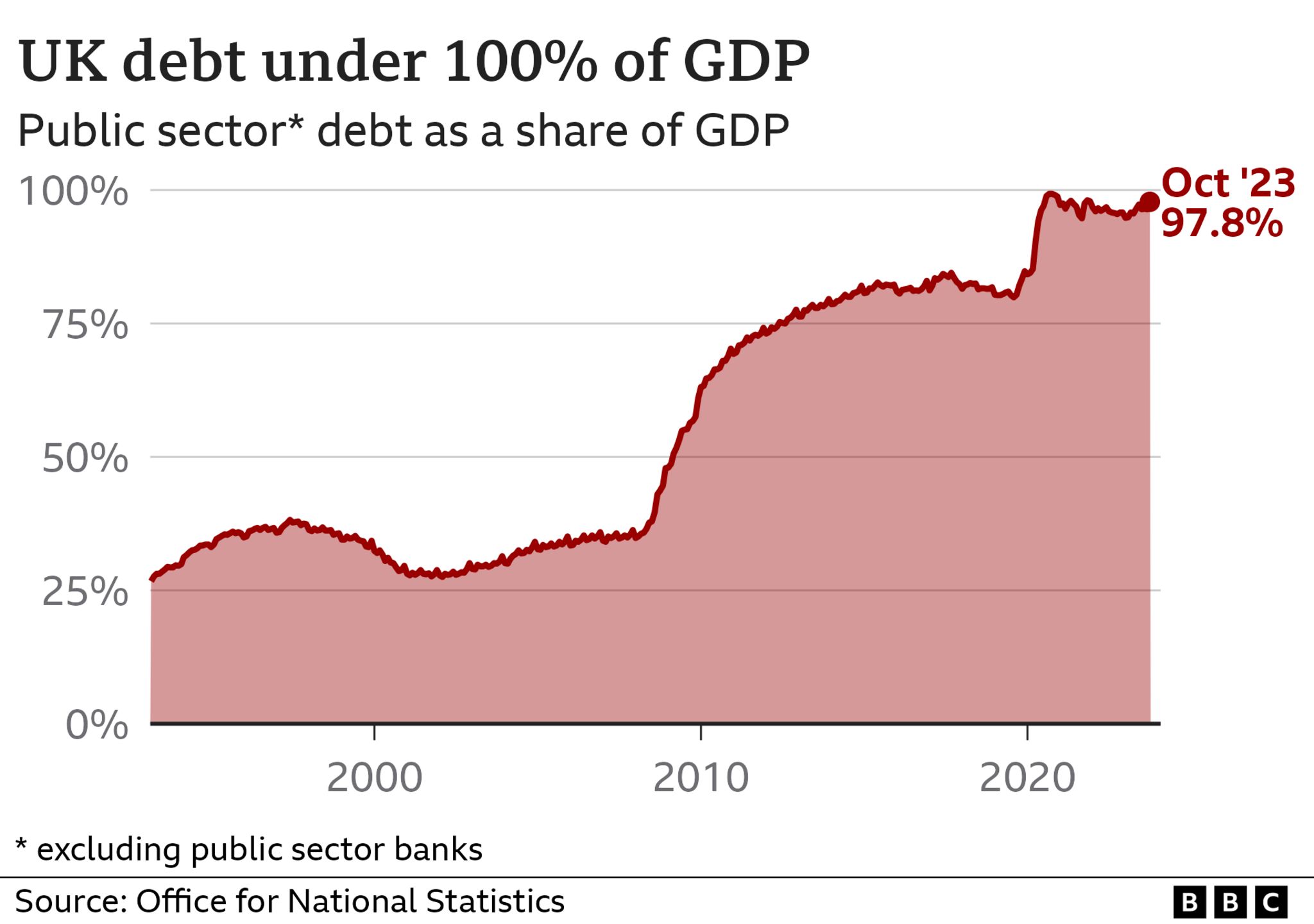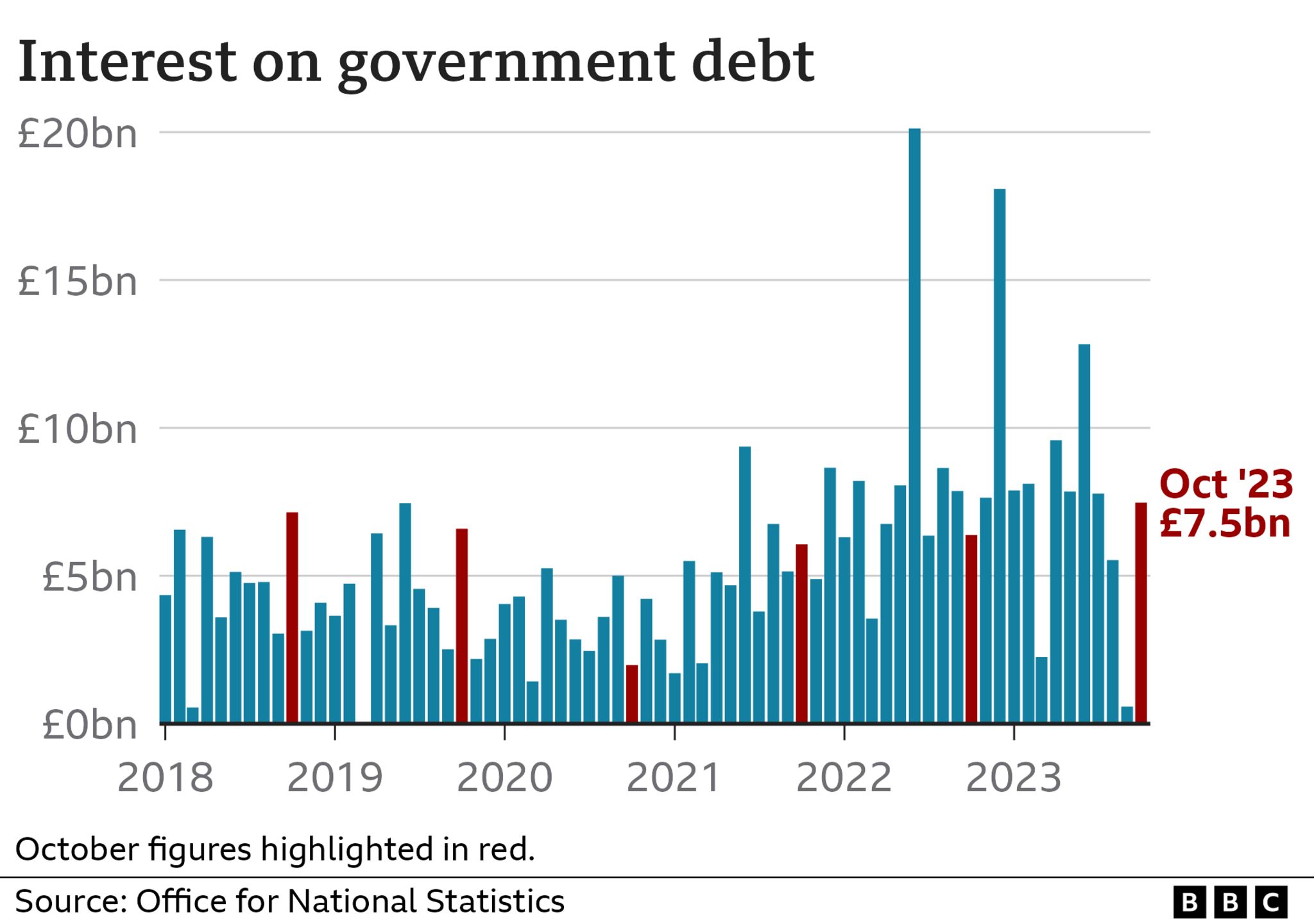The government is spending more on public services than it raises in tax.
To bridge this gap it borrows money, but this has to be paid back – with interest – and that can influence wider tax and spending plans.
Why does the government borrow money?
The government gets most of its income from taxes. For example, workers pay income tax, everyone pays VAT on certain goods and companies pay tax on their profits.
It could, in theory, cover all of its spending from taxes, and in some years that happens.
But if it can’t, it will cover the gap by raising taxes, cutting spending or borrowing.
Higher taxes mean people have less money to spend, so businesses make less profit, which can be bad for jobs and wages. Lower profits also mean companies pay less tax.
So, governments often borrow to boost the economy. They also borrow to pay for big projects – such as new railways and roads – which they hope will help the economy.

How does the government borrow money?
The government borrows money by selling financial products called bonds.
A bond is a promise to pay money in the future. Most require the borrower to make regular interest payments over the bond’s lifetime.
UK government bonds – known as “gilts” – are normally considered very safe, with little risk the money will not be repaid.
Gilts are mainly bought by financial institutions in the UK and abroad, such as pension funds, investment funds, banks and insurance companies.
The Bank of England has also bought hundreds of billions of pounds’ worth of government bonds in the past to support the economy, through a process called “quantitative easing”.
How much is the UK government borrowing?
The amount the government borrows varies from month to month.
For instance, when people submit tax returns in January, they often pay a large chunk of their annual tax bill in one go, so the government sees a jump in the amount of money it takes in.
So it is more helpful to look at the whole year, or the year-to-date.
In the 2022-23 financial year, the government borrowed £127.8bn. That was £5bn higher than in the previous year.
In October 2023, the government borrowed £14.9bn, which was the second highest borrowing figure for October since monthly records began in 1993.
The total amount the government owes is called the national debt. It is currently about £2.6 trillion.
That is roughly the same as the value of all the goods and services produced in the UK in a year, known as the gross domestic product, or GDP.

That current level is more than double what was seen from the 1980s through to the financial crisis of 2008.
The combination of the financial crash and the Covid pandemic pushed the UK’s debt up from those historic lows to its current level.
But in relation to the size of the economy, today’s debt figures are still low compared with much of the last century, as shown above, and also compared with some other leading economies.
How much money does the government pay in interest?
The larger the national debt gets, the more interest the government has to pay.
That extra cost was not as big when the interest rates due were low through the 2010s, but it is more noticeable now that interest rates have been rising.
If the government has to set aside more cash for paying its debts, it may mean it has less to spend on the public services which it borrowed to fund in the first place.
The amount of interest the government pays on national debt fluctuates, and by one measure, hit a 20-year high in early October 2023.
The most significant figures tracking the cost of debt are published monthly by the Office for National Statistics (ONS).
According to this data, two months in 2022 saw record levels of money set aside for debt interest: £20bn in June and £18bn in December.
June 2023 saw the third largest monthly amount – £12.8bn.
The most recent October figure revealed interest on government debt was £7.5bn.

During the 2022-23 financial year, the government spent £108bn on debt interest – more than it spent on education.
Why does it matter if governments borrow more?
Some economists fear the government is borrowing too much, at too great a cost.
Others argue extra borrowing helps the economy grow faster – generating more tax revenue in the long run.
In July, the government’s official economic forecaster, the Office for Budget Responsibility (OBR), warned that public debt could soar as the population ages and tax income falls.
In an ageing population, the proportion of people of working age drops, meaning the government takes less in tax while paying out more in pensions.
The OBR says debt could rise to more than 300% of GDP by 2070.
It also says climate change poses a “significant” risk to government finances. Other economists argue that big economies like the UK could borrow much more than they currently do, and the negative impact is greatly exaggerated.
What is the government’s plan for debt?
Responding to the OBR report, Chancellor Jeremy Hunt said the government would take “difficult but responsible” decisions on the public finances.
He previously blamed the “twin global emergencies of a pandemic and Putin’s war in Ukraine” for driving up government costs.
The chancellor has set a target of getting underlying debt to fall in five years’ time.
Prime Minister Rishi Sunak also made reducing the national debt one of his five key promises.
What is the difference between the government deficit and debt?
The deficit is the gap between the government’s income and the amount it spends.
When a government spends less than its income, it has what is known as a surplus.
Debt is the total amount of money owed by the government that has built up over years.
It rises when there is a deficit, and falls in those years when there is a surplus.







